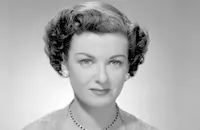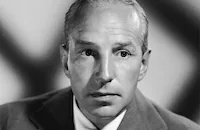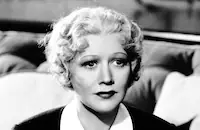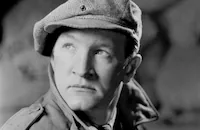The House Across the Bay
Brief Synopsis
Cast & Crew
Archie Mayo
George Raft
Joan Bennett
Lloyd Nolan
Walter Pidgeon
Gladys George
Film Details
Technical Specs

Synopsis
Steve Larwitt, a New York nightclub operator, falls in love with torch singer Brenda Bentley and marries her. To impress his wife, Steve acquires another nightclub, a distillery, a munitions works and several race horses, using ruthless methods in his upward climb. Suddenly, his empire collapses as he faces charges of income tax evasion and is fired upon by rival racketeers. Brenda, realizing that her husband's life is in danger, believes that by spending a year in jail, he will pay his debt to society and be safe. When Slant Kolma, Steve's lawyer who is in love with Brenda, leads her to believe that the court will let Steve off with a lenient sentence, Brenda secretly furnishes the government with evidence that will put her husband behind bars. Slant double-crosses Steve, however, and as a result, he is sentenced to ten years at Alcatraz. To be near her husband, Brenda follows him to San Francisco and rents an apartment overlooking the bay. While on the boat returning from a visit to Steve, Brenda meets Mary Bogale, another "rock widow" who befriends her. One night, while waiting to call a taxi for Mary, Brenda meets airplane builder Tim Nolan, who is enchanted by her beauty. Tim persists in calling Brenda until she agrees to see him, and although she is attracted to Tim, she remains faithful to Steve. While lunching one afternoon, Brenda and Tim encounter Slant, who insists upon seeing Brenda. That night, after informing Brenda that she is broke, Slant announces his love for her and threatens to tell Steve that Brenda framed him and has been seeing Tim. To protect Tim, Brenda disappears to Alameda, and out of spite, Slant tells Tim about Brenda's marriage to Steve. Rather than foresake Brenda, Tim traces her to Alameda, where she tells him that she must remain loyal to Steve because she is all he has. A jealous Slant watches as Brenda and Tim talk, and the next day, he tells Steve that Brenda framed him and is having an affair with Tim. Insanely jealous, Steve breaks out of Alcatraz and is about to strangle Brenda when Tim enters and tells him that Slant is his betrayer. Realizing that Brenda has been faithful to him and that Tim can make her happy, Steve kills Slant and then swims to his death as the Alcatraz guards fire on him.

Director

Archie Mayo
Cast

George Raft

Joan Bennett

Lloyd Nolan

Walter Pidgeon

Gladys George

Peggy Shannon
June Knight

Joseph Sawyer
Billy Wayne
George Renavent

Joseph Crehan
Edward Fielding
Virginia Brissac
Miki Morita
Etta Mcdaniel

Cy Kendall
William Halligan
Kenneth Harlan
Ed Marr
Norman Willis
Jean O'donnell
Edith Haskins
Mitzi Uehlein
Lurline Uller
Kay Gordon
Pearlie Mae Norton
Victoria Vinton
Jim Farley
Franklyn Farnum
Pat O'malley
Martin Cichy
Paul Phillips
John Bohn
Max Hoffman Jr.
Don Kerr
Sam Ash
Sam Wren
Harry Tyler
Max Wagner
Frank Bruno
Mack Gray
Sam Finn
Marcelle Corday
Frances Morris
Freeman Wood

James Craig
Jack Lubell
Harry Harvey
Isabel Withers
Dorothy Vaughn
Ruth Warren
Maxine Leslie
Helen Shipman
Kitty Mchugh
Armand "curly" Wright
Harrison Green
Charles Griffin
Elsa Peterson
Peter Camlin
Jean Del Val

Emmett Vogan
Allen Wood
Herbert Ashley
Crew
Ray Binger
Nick Castle
Sidney Clare
Myles Connolly
James Dent
Merritt Gerstad
Alexander Golitzen
Julia Heron
Irene
Richard Irvine
Werner Janssen
Werner Janssen
Dan Keefe
Charles Kerr
Jack Kirston
Fred Lau
Sammy Lee
Otho Lovering
Frank Maher
Paul Price
Walter Reynolds
Kathryn Scola
Al Siegel
Dorothy Spencer
Jule Styne
Trabert, Hoeffer And Mauboussin
William Walling Jr.
Walter Wanger
Walter Wanger

Photo Collections
Film Details
Technical Specs

Articles
The House Across the Bay
Rarely seen since its initial release except for infrequent airings on television, The House Across the Bay (1940) is, on the surface, the sort of crime drama that became a genre specialty of Warner Bros. Except that The House Across the Bay was an independent feature, produced by Walter Wanger and released by United Artists. While the production budget is noticeably lower than the standard Warner Bros. programmer, the film is interesting for its powerhouse cast, fast pace and quirky, unexpected moments such as Joan Bennett performing a Carmen Miranda-like musical number called "Chula Chihuahua."
More importantly, the film was released at the peak of George Raft's popularity in the movies; the same year his screen immortality was confirmed when he left his handprints and signature in cement at Grauman's Chinese Theatre. But while Raft appeared to be riding high, there was trouble brewing behind the scenes. Recently signed by Warner Bros., Raft was already feuding with studio management over his refusal to play another "heavy" in a movie. In a memo to Jack Warner, Raft wrote, "I was afraid the studio would put me into parts that Humphrey Bogart should play, and you told me I would never have to play a Humphrey Bogart part." In effect, Raft refused to play the lead in a project entitled King of the Roaring Nineties and earned his first suspension at the the studio. That's when he decided to accept an offer from United Artists to appear in The House Across the Bay after pleading with Warner Bros. to allow him permission to do the loanout. Hal Wallis, the producer on a previous Raft picture (Invisible Stripes [1939]), was particularly surprised to hear Raft say that if he couldn't appear in The House Across the Bay, it would have an adverse effect on his film career. It was a curious decision on Raft's part because in this Walter Wanger melodrama, directed by Archie Mayo, his role was no different from the racketeer character parts he had accepted at Warner Bros. Yet, it is quite possible that Raft's squabble with his studio had the intended effect he wanted because after completing The House Across the Bay, he returned to Warner Bros. and made two of his best pictures there - They Drive By Night (1940) and Man Power (1941).
1940 was also an important year for producer Walter Wanger who married actress Joan Bennett. Wanger was a true independent who produced movies for almost every studio in Hollywood and at the time was enjoying the success of his 1939 hit Stagecoac and the critical acclaim generated by the releases of The Long Voyage Home and Alfred Hitchcock's Foreign Correspondent (both 1940). Unfortunately, all four of Wanger's 1940 releases, which also included The House Across the Bay and Slightly Honorable, lost money and he was forced to take cost-cutting measures. Among these were terminating the exclusive contracts of his top stars such as his wife Bennett, Henry Fonda, and Charles Boyer. Bennett, who was still riding high on the popularity of her 1938 success Trade Winds, decided to hire herself a new agent, MCA representative Jennings Lang, and sign a nonexclusive contract with Twentieth Century-Fox.
The House Across the Bay marked the last of Bennett's films under the guidance of Wanger until Scarlet Street in 1945 and it is a fitting showcase for her beauty and sex appeal with a noticable emphasis on her wardrobe (according to production notes, Bennett has 26 costume changes throughout the film). Raft is equally charismatic and generates more sympathy for his underworld character that you'd expect from the formulaic scenario. But what really distinguishes The House Across the Bay from other crime thrillers of the forties are some vivid supporting performances by Lloyd Nolan as the devious weasel-of-a-partner, Joe Sawyer as a blustery and quick-to-anger friend of Brenda's, and Gladys George, who steals most of her scenes as Brenda's streetwise and often inebriated friend. Walter Pidgeon, who was on loanout from MGM, has the most colorless role of all but still manages to invest it with his usual charm and affability.
The filming of The House Across the Bay was reputedly non-eventful except for a brief flareup between director Archie Mayo and Raft, who walked off the set for few days, according to Joan Bennett. The actress also claimed that Mayo was called away from the film before completing it and that Alfred Hitchcock was called in to reshoot the final scenes of the movie. Whether this is true or not, it is hard to discern the Hitchcock touch in the rushed and wildly incongruous climax.
The House Across the Bay was not a boxoffice success or popular with critics. Variety stated that the "picture will not help the popularity of either Raft or Miss Bennett" and The New York Times critic Frank S. Nugent was more specific. He wrote, "Mr. Wanger's production of this melodrama of wifely loyalty and legal double-crossing is far more handsome and more opulent than either the theme or the performance merits. Prison pictures are bad at best, so familiar have they become, and we regard as a singularly wasteful business practice that of chartering a gilded barge to carry coals to Newcastle. Although Miss Bennett is awesomely gowned, her film is old hat and scarcely worth its maker's bother-or yours."
Despite this, The House Across the Bay is worth a look for Raft and Bennett fans and it deserves a footnote in the Bennett-Wanger relationship. The same year the film was released, Wanger was charged with shooting Bennett's new agent, Jennings Lang, in the groin after suspecting him of having an affair with his wife. Lang was not seriously injured and Wanger got off with a light four-month prison sentence, thanks to a successful "temporary insanity" defense plea. Bennett stood by her husband and supported him during this difficult period; they would remain married for twenty-five years and divorce in 1965. After the Lang incident, Wanger returned to filmmaking, winning a Honorary Oscar® in 1946 for his service as President of the Academy of Motion Picture Arts and Sciences. He would later produce such major films as I Want to Live! (1958) and Cleopatra (1963).
Producer: Walter Wanger
Director: Archie Mayo
Screenplay: Myles Connolly, Kathryn Scola
Cinematography: Merritt B. Gerstad
Art Direction: Alexander Golitzen, Richard Irvine
Music: Walter Janssen
Film Editing: Dorothy Spencer
Cast: George Raft (Steve Larwitt), Joan Bennett (Brenda Bentley), Lloyd Nolan (Slant Kolma), Walter Pidgeon (Tim Nolan), Gladys George (Mary Bogel), Billy Wayne (Barney), June Knight (Bebe), Joe Sawyer (Charlie), Peggy Shannon (Alice).
BW-88m.
by Jeff Stafford
SOURCES:
George Rft: The Man Who Would Be Bogart by Stone Wallace with a foreward by Alan K. Rode
The Bennetts: An Acting Family/I> by Brian Kellow
www.afi.com
IMDB

The House Across the Bay
Quotes
Trivia
Hitchcock shot some scenes involving actors Pidgeon and Bennett in a plane. They state he did this as a favor to this film's producer Walter Wanger, with whom Hitchcock had worked on Foreign Correspondent (1940).
Notes
Although the film credits Frank Maher with sound, credit information from Walter Wangger Production lists Fred Lau. The Walter Wanger Productions credit sheet also notes that Joan Bennett had 26 costume changes in the film. A news item in Hollywood Reporter notes that in February 1939, Warner Bros. also considered filming the Myles Connolly story on which this film is based as a vehicle for Marlene Dietrich and James Cagney.















